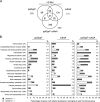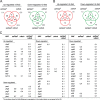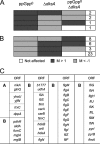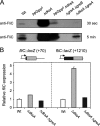Similar and divergent effects of ppGpp and DksA deficiencies on transcription in Escherichia coli
- PMID: 19251846
- PMCID: PMC2687150
- DOI: 10.1128/JB.01410-08
Similar and divergent effects of ppGpp and DksA deficiencies on transcription in Escherichia coli
Abstract
The concerted action of ppGpp and DksA in transcription has been widely documented. In disparity with this model, phenotypic studies showed that ppGpp and DksA might also have independent and opposing roles in gene expression in Escherichia coli. In this study we used a transcriptomic approach to compare the global transcriptional patterns of gene expression in strains deficient in ppGpp (ppGpp(0)) and/or DksA (DeltadksA). Approximately 6 and 7% of all genes were significantly affected by more than twofold in ppGpp- and DksA-deficient strains, respectively, increasing to 13% of all genes in the ppGpp(0) DeltadksA strain. Although the data indicate that most of the affected genes were copositively or conegatively regulated by ppGpp and DksA, some genes that were independently and/or differentially regulated by the two factors were found. The large functional group of chemotaxis and flagellum synthesis genes were notably differentially affected, with all genes being upregulated in the DksA-deficient strain but 60% of them being downregulated in the ppGpp-deficient strain. Revealingly, mutations in the antipausing Gre factors suppress the upregulation observed in the DksA-deficient strain, emphasizing the importance of the secondary channel of the RNA polymerase for regulation and fine-tuning of gene expression in E. coli.
Figures







References
-
- Aberg, A., V. Shingler, and C. Balsalobre. 2006. (p) ppGpp regulates type 1 fimbriation of Escherichia coli by modulating the expression of the site-specific recombinase FimB. Mol. Microbiol. 601520-1533. - PubMed
-
- Aberg, A., V. Shingler, and C. Balsalobre. 2008. Regulation of the fimB promoter: a case of differential regulation by ppGpp and DksA in vivo. Mol. Microbiol. 671223-1241. - PubMed
-
- Bradley, M. D., M. B. Beach, A. P. de Koning, T. S. Pratt, and R. Osuna. 2007. Effects of Fis on Escherichia coli gene expression during different growth stages. Microbiology 1532922-2940. - PubMed
-
- Braeken, K., M. Moris, R. Daniels, J. Vanderleyden, and J. Michiels. 2006. New horizons for (p) ppGpp in bacterial and plant physiology. Trends Microbiol. 1445-54. - PubMed
Publication types
MeSH terms
Substances
LinkOut - more resources
Full Text Sources
Molecular Biology Databases

